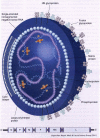Progress in the development of human parainfluenza virus vaccines
- PMID: 21859271
- PMCID: PMC3503243
- DOI: 10.1586/ers.11.32
Progress in the development of human parainfluenza virus vaccines
Abstract
In children under 5 years of age, human parainfluenza viruses (HPIVs) as a group are the second most common etiology of acute respiratory illness leading to hospitalization, surpassed only by respiratory syncytial virus but ahead of influenza viruses. Using reverse genetics systems for HPIV serotypes 1, 2 and 3 (HPIV1, 2 and 3), several live-attenuated HPIVs have been generated and evaluated as intranasal vaccines in adults and in children. Two vaccines against HPIV3 were found to be well tolerated, infectious and immunogenic in Phase I trials in HPIV3-seronegative infants and children and should progress to proof-of-concept trials. Vaccines against HPIV1 and HPIV2 are less advanced and have just entered pediatric trials.
Figures


References
-
- Black RE, Cousens S, Johnson HL, et al. Global, regional and national causes of child monality in 2008: a systematic analysis. Lancet. 2010;375(9730):1969–1987. - PubMed
-
- O'Brien KL, Wolfson LJ, Watt JP, et al. Burden of disease caused by Streptococcus pneumoniae in children younger than 5 years: global estimates. Lancet. 2009;374(9693):893–902. - PubMed
-
- Watt JP, Wolfson LJ, O'Brien KL, et al. Burden of disease caused by Haemophilus influenzae type b in children younger than 5 years: global estimates. Lancet. 2009;374(9693):903–911. - PubMed
Publication types
MeSH terms
Substances
Grants and funding
LinkOut - more resources
Full Text Sources
Other Literature Sources
